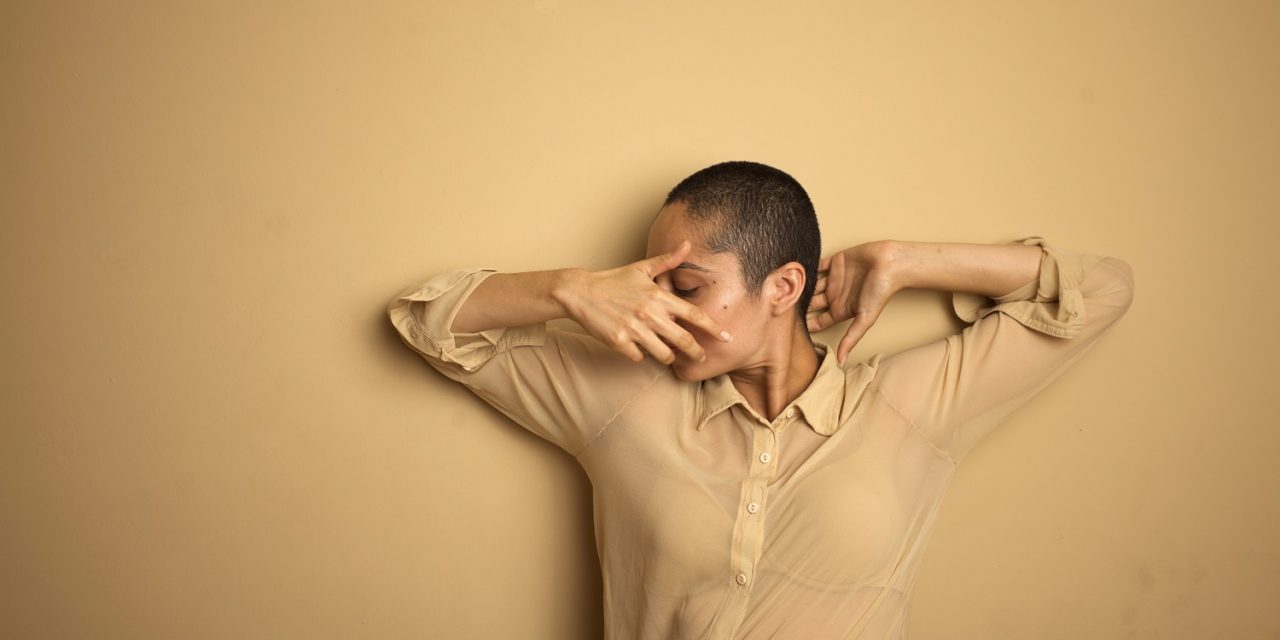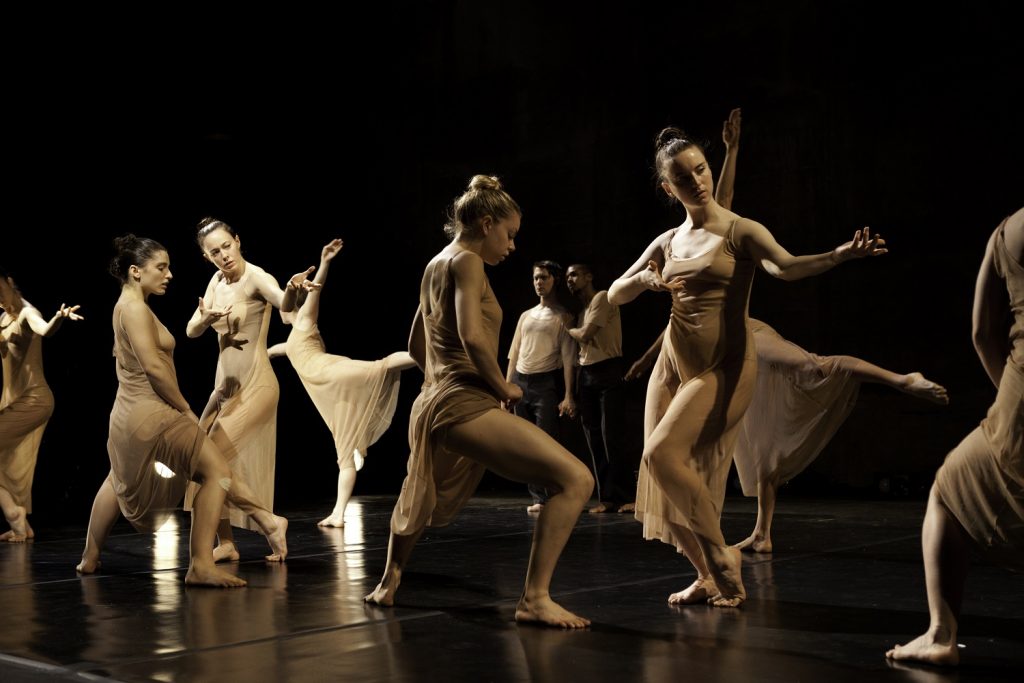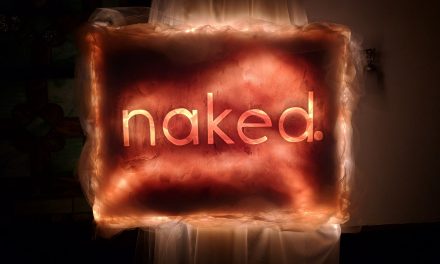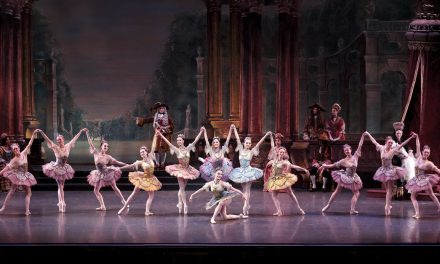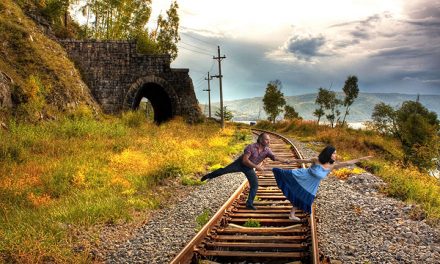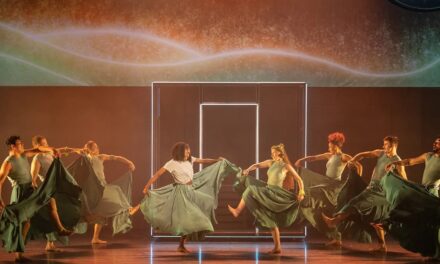Ate9 Dance Company’s artistic director Danielle Agami returned to her roots with Old/News last weekend, October 20 through Monday, October 22, a two-piece show commissioned for Temple Israel of Hollywood (TIOH) Arts & Culture. The two works included the wonderfully weird Old/News, an updated version of her first work with Ate9 called Sally Meets Stu (2012) and the LA premiere of Framed, a brand-new piece which hones in on Agami’s sense of womanhood. Both were cutting edge and raw, using well-balanced dark humor as a vehicle to discuss personal relationships through Agami’s distinguished style of choreography.
The show took place within TIOH’s chapel—an appropriate location for a show so heavily focused on introspection. Old/News began in the darkness as ten dancers quietly entered at the opposite end of the room to sit on chairs and wait as semi-distorted house music blasted overhead for what felt like a minute or two. After it stopped, the group stood in silence and took a few steps toward the audience before beginning to heatedly spin and twirl, forming individual bubbles of movement before suddenly syncing into two rows slow-moving through gelatin with intermittent reflexive blocking and pull-back motions. One performer, Rebecah Goldstone detached from the group and threw herself at various male dancers who passed her off between them until she was eventually kept and cradled by Montay Romero. The two then engaged in a quirky duet to writer/performer Nadav Heyman, who wrote an engaging story about two lovers, Sally and Stu, whose comic contemporary affairs led to melancholic endings that served as social commentary about the evolution of modern relationships.
Divided into consecutive girl-meets-boy scenarios that followed the love, sex and marriage routine before branching off into separate storylines, the movement followed Heyman who loudly recounted the details as though reading a “Dick and Jane” book. Each pose poetically blended into the next as the couple moved both abstractly and purposely, bending their bodies to bring Heyman’s world to life, new shapes smoothly flowing into the next. Tensity and tenderness characterized the evolution of every dance. Body rolls and gentle stretches made the dancers look like morphing statues briefly pausing after shifting their carriage so that the viewers could absorb the meaning behind the words as Heyman continued to speak. The synopses ranged from Sally and Stu becoming world travelers who settled down and lost their enthusiasm for life, to a flavorless matrimony reinvigorated by newly developed appreciation after both parties suffer an accident and illness that causes them to lose a limb and a breast. The rest of the ensemble sat in the back, watching the developing scenes, which they occasionally joined as muses before swapping places with them to become the new Stu and Sally.
In between, the ensemble went back to their dramatic dancing, running forward in twos and threes as they presented their own versions of Old/News’ introduction. The original movement involved twitching, winding their torsos, jumping upward and rolling their bodies closer to the floor in moves reminiscent of Middle Eastern dancing. The tan-clad dancers minus Heyman (who was additionally dressed in black to distinguish himself from the rest) grooved to what sounded like Israeli club music. Suddenly, the tune was taken over by soft piccolos and elevated to something lighter and more romantic. Heyman, Goldstone , Alexander Quetell and especially Genna Moroni performed standout solos during this section of the dance, demonstrating strong presence, complicated emotions and ample frustration through their facial expressions and energy.
The dancing continued but shifted slightly to fit the new melody. Finally, the piece concludes with a sad and surreal portrayal of “Scenario #5”. In this version, Sally meets Dan, the two feel no passion for each other but decide to get married anyway, and the final result is a drinking problem, an unhappy marriage and Sally’s development of Alzheimer’s at 70 wherein she begins to call Dan Stu. Heyman delivers the story in a subdued tone, which strips away all of the sarcasm portrayed in the rest of his stories. Combined with the images the dancers create by lining up on either side of him as though at an altar, falling backward onto each other, lifting and carrying one another away from the front of the procession, and finally fading away, the symbolism of marriage blurring into a funeral-like setting for love and genuineness. This is not the last portrait painted by Old/News, but it is the one that stay with you long after the show’s conclusion, it’s haunting image a warning against the tragedy of settling into a half-lived life.
After a brief, 10-minute intermission, the Agami performed her solo, Framed, a narrative of her emotions as portrayed through dialogue and dance. The piece began with Agami swaying by herself to no music in the back of the chapel. She inched her body closer to the crowd, pushing and pulling on the air around her as though maneuvering through a confined space to get to the front. Once there, she suddenly turned to walk off stage, initiating a sentimental string soundtrack to her next few generous and funny moves: returning from behind the curtain with snacks such as popcorn, pretzels and soda as an indication to her audience to get comfortable. She brought out large, well-wrapped gifts for the front row, an audience member took a picture of her with a polaroid as she alternated between cute and sexy poses, and finally she settled onto the floor and went into her background.
“I hate my legs” was the comment Agami opened with, describing them with a distasteful look on her face as she goes between blaming her mother for giving them to her and praising her instilling a sense of identity and saying what she means. She is a woman who doesn’t fit into her background or surroundings. The feeling is best described through her relationship with Israel—a place she loves, but where she feels uncomfortable being a woman. This frames the rest of the brash piece, characterized by saucy stances, bold opinions and a desire to push the boundaries in order to make the viewers feel how she feels.
Her biggest hurdle seems to be finding love with the confidence she carries. A duet with a gentleman posing as a spectator represents a failed relationship shown falling apart through their forced hugging, brash grabbing, attempts at slapping, unhappy expressions and a final awkward handshake goodbye. Afterward three Ate9 dancers alternate between pulling random viewers up to their feet, introducing them to Agami as potential options for dating—their diverse backgrounds and interests are comic but disinteresting to her. Through her rejections, she never states what she’s looking for, only that it’s hard to find.
Props play a big role in this work. The gifts she presents the audience with are swiftly taken away a few scenes later. Many of the images she creates are examples of failure or the dark side of her life. When she is most frustrated, Agami either eats her stress, pulling out junk food and booze which she consumes while wearing old loungewear, or pulls out a punching bag to take her anger out on its floppy structure, while demonstrating her strength of will. A pillow with a realistic image of a cat is presented to her as she listens to Bobby Viton’s “I’m Mr. Lonely”, causing the audience to break down into loud laughter. Moments later this is contradicted with an attempt at slicing her wrist, the sharp knife she used to cut limes pressed firmly into her skin until is forcefully taken away from her.
In-between her acted scene, Agami dances. She is often desperate, twitching furiously enough to have her limbs detach from her as her hands and feet grow rigid. Her personal style, which includes body rolls and curved angles is present throughout. Her final moves ended with her pointing at the door, indicating that the viewers should leave as she continued to feel herself, accepting herself and her situation for what it is.
Old/News walked the thin line between remaining relatable to viewers while creating movements that tested the limits of dance and performance art. The two contrasting shows demonstrated the company’s growth, while presenting returning enthusiasts and first-time viewers with a strong sense of Ate9’s style of honesty through bold movement.
For information on Ate9 Dance Company, click here.
Featured image: Ate9 Artistic Director Danielle Agami – Photo: Scott Simock

